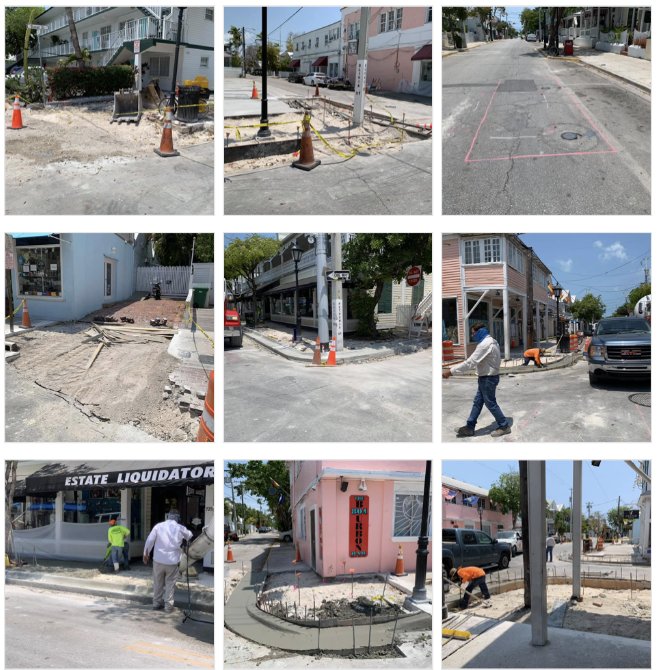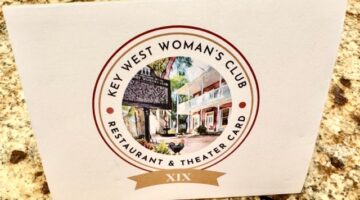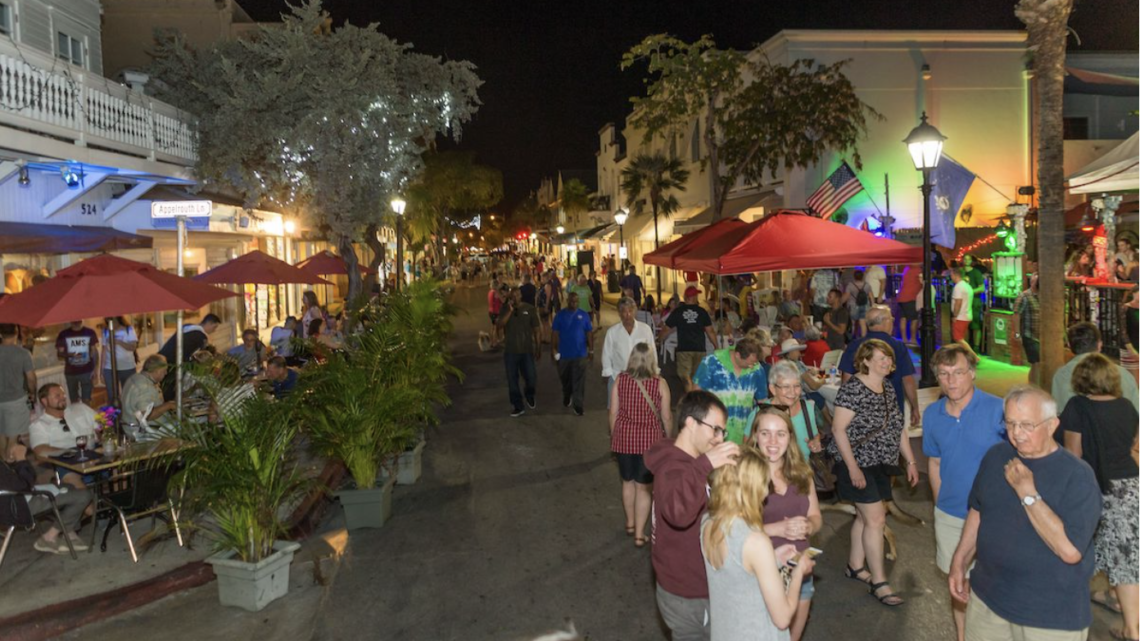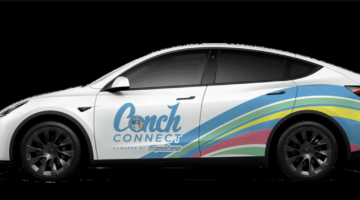Streets for People Improves Our Environment, Affordable Housing, Health, and Safety. It Boosts a Local’s Economy and Makes Us Happier Too
Think about some of today’s big problems in Key West and cities across the country. A degrading environment, rising seas and threatening weather events. A lack of affordable housing. Climbing obesity and depression rates. Pedestrian deaths at 40-year high. Did you ever think that by using our streets and sidewalks just a bit differently they could be part of the solution to these problems? And even Improve our downtown local’s economy and make us happier? Well, yes, they certainly can.
We started writing about these issues here at Friends of Car-Free Key West & Duval Street/Historic Downtown during the COVID shutdown on April 22, 2020, with this popular article. With this being our 100th article since then, we’re going back to our origin story about why our streets are so important that we named this column “Streets for People.”
Our Streets and Sidewalks, An Asset In Plain Sight

Streets and sidewalks take up 25 to 50 percent of a typical U.S. city’s land. New York City, for example, is on the lower end of that scale at 28 percent and Chicago (42 percent), Washington D.C. (43) and Portland, Oregon (47) are at the higher end. Key West City staff estimated our number to be about 26% which is in line with older cities. As former New York City Transportation Commissioner Janette Sadik-Khan says: “Streets are some of the most valuable resources that a city has, and yet it’s an asset that’s largely hidden in plain sight.”
How does using this asset help us tackle these problems and improve our lives?
By designing our streets and sidewalks to prioritize people, not cars.
And since streets and sidewalks represent space that’s largely under control of our local government, that means we the people can do something about it and take responsibility to improve our own lives.
What the Research Says About These Issues and Car-Centric Cities
Emerging research over the last two decades tells us that using our streets more efficiently by prioritizing walking, bicycling and transit and using cars less addresses all of these problems. Here’s just a very small sampling:
On Our Environment
Says the non-profit America Walks: “When we design cities for cars, we’re actively making them more hostile for the planet as well as people who get around without driving. This hostility leads to negative outcomes in the areas of climate and public health.”

Yale Climate Connections says: “Transportation is the largest source of planet-warming gases in the United Sates, and passenger vehicles are the top emitters within the sector, to reduce car emissions, authorities ranging from the UN to the U.S. EPA and Department of Transportation say that people need to drive less.”
“Our transportation system is making us – and the planet – sick, and the problem lies in the fossil fuel-powered automobile which has taken over how we live an and use space. Thankfully, solid urban planning + new technology has opened the door for us to bring our cities back from the brink, but we need to act quickly to ensure our communities will be places we want to live.” Gabe Klein, in the “Cars Almost Killed Our Cities, But Here’s How We Can Bring Them Back” TED Talk.
On Affordable Housing
“Living in areas with limited transportation options can lead to higher transportation costs. Households in car-dependent neighborhoods spend up to 25% of their income on transportation, compared to just 9% in more walkable neighborhoods with more transit options.” From the Impact of Transportation on Access to Affordable Housing, Rajiv Desai.
“Three of the nation’s poorest cities are actually the most expensive places to live – when you factor in how much it costs to get around, and not how much it costs to pay the rent.” Says Kea Wilson in her article Car-Dependency Makes City-Life Too Expensive
On a Downtown’s Local’s Economy
“Street projects that improve safety and design and that welcome pedestrians, cyclists, and transit riders see higher retail sales.” From The Economic Benefits of Sustainable Streets
Twelve different studies in 12 different cities “And they all reach a similar conclusion: replacing on-street parking with a bike lane has little to no impact on local business, and in some cases might even increase business. While cyclists tend to spend less per shopping trips than drivers, they also tend to make more trips, pumping more total money into the local economy over time.” From the article The Complete Business Case for Converting Street Parking Into Bike Lanes
“We’ve got data unequivocally showing that people-oriented streets are more economically productive than auto-oriented streets.” From “Why Walkable Streets are More Economically Productive”
On Safety

“We should always be designing our roadways for people, not cars. Safety for pedestrians comes down to street design.” From Dangerous by Design? Why Planning for People Not Cars Creates Safer Roads by the Center for Planning Excellence
“The study found the main reason for this was the traffic calming effect protected bike lanes have on all road users. With protected bike lane street designs, traffic speeds are lowered, so when collisions do occur, they are far less likely to be fatal, and this protects everyone. Let’s face it, people make mistakes, but designing streets for slower speeds means fewer of those mistakes result in people dying.” From the article A Reminder that Protected Bike Lanes Can Make Streets Safer for Everyone
“New York City found that with protected bike lanes, serious injuries and accidents to all users – not just cyclists but drier too – dropped.” From Jeff Speck on Why Bikes Make Streets Safer for All
On Physical and Mental Health
Research brought to light by The Happy City author Charles Montgomery shows how car-centric places do bad things to our physical and mental health:
- They add unhealthy pounds to our bodies. They make us more likely to have heart and respiratory issues. They shorten our lives.
- Their streets are made for cars and to speed cars through. This is unsafe, not just for those who bike and walk but for those who drive too.
- They cause us more stress. That stress exacerbates physical and mental-health issues.
- They make us, especially those with longer car commutes, more likely to experience rage, fear, depression and even get divorced, more than people who walk, bike, or use transit to get to work.
- They make us feel isolated and less connected to one another, which causes us to feel less trusting, and ultimately less happy.
He goes on to say: “If you build the road space, the cars come. But if you build a city for pedestrians, for people, then you can actually create a more social city, a more connected city, and a happier city. And this is now happening in cities around the world.”
Addressing Today’s Problems By Prioritizing Streets for People over Cars
So, what can our local City of Key West and Monroe County governments do to address these problems via our streets and sidewalks? Lots, especially by thinking creatively and fixing our car-centric infrastructure one street or one corridor or one project at a time.
Streets for People means prioritizing people who walk over cars.
It looks like skinny streets that are nine or 10 feet instead of the standard 12 feet per lane. Usually two-way, not one-way streets. Narrow crosswalks, including bulb outs. Mid-block crosswalks. Shortcuts. Paths. Places to rest and for refuge.
Streets for People means prioritizing people who bike over cars.
It looks like more than just bike lanes, but protected and buffered bikeways. Not isolated projects but whole networks that connect us all over town. For example, finishing the Southard Street bike lane. It means taking car parking and converting it to bikeways and bike-corral parking in retail and dense residential areas.
Streets for People means prioritizing people who use transit over cars.
It looks like we care about people who use transit because we provide amenities like benches, shelters, lighting, and trash cans. Real-time arrival signs. Maps and schedules. Branded and clean buses. And it most importantly means frequent and easy to understand service.
Streets for People means prioritizing people who want to shop, eat, sit, chat, socialize, and watch each other rather than prioritizing on-street car parking.
It looks like the parklets made from parking spaces or reclaimed streets turned into pedestrian plazas with benches and tables and chairs. It means promoting retailers and restaurants to reclaim street space and even food trucks and pop-up retail in other places. It means street trees, trash cans, water fountains and public restrooms like are envisioned in the Duval Street Resiliency Plan.

Streets for People
If a city speaks of “balancing transportation choices” rather than prioritizing walking, biking, and transit, it’s still car centered. So, in Key West we need to turn upside down the prevailing car-centric mindset and even push back on those calling for balance.
If we make our streets and sidewalks more people centered, and if we help make it easy and safer for more people to walk, bike, and take transit, our little island paradise will be greener. More prosperous. More affordable. More physically healthy. And yes, more mentally healthy, and happy too.
# # #
Featured photo at top is from the Keys Weekly Newspaper.
Chris Hamilton is founder of the local advocacy group Friends of Car-Free Key West & Duval Street/Historic Downtown. Subscribe to the blog. Follow on Facebook and Twitter. Support ($) our local journalism here. A native of the District of Columbia, where for a couple decades+ he led nationally renowned efforts promoting transit, bike, walk and smart growth for Arlington County, VA’s DOT. Chris has lived in Key West since 2015. He lives car-free downtown and works and volunteers for a few non-profits. You can find three years’ worth of KONK Life Streets for People column articles here and here.
[livemarket market_name="KONK Life LiveMarket" limit=3 category=“” show_signup=0 show_more=0]





No Comment